|
Philetairus socius (Sociable
weaver)
Versamelvoël [Afrikaans]; Thantlagane [North Sotho]; Kgwêrêrê
[Tswana]; Republikeinwever [Dutch]; Républicain social [French];
Siedelweber [German]; Tecelão-sociável [Portuguese]
Life
> Eukaryotes >
Opisthokonta
> Metazoa (animals) >
Bilateria >
Deuterostomia > Chordata >
Craniata > Vertebrata (vertebrates) > Gnathostomata (jawed
vertebrates) > Teleostomi (teleost fish) > Osteichthyes (bony fish) > Class:
Sarcopterygii (lobe-finned
fish) > Stegocephalia (terrestrial
vertebrates) > Tetrapoda
(four-legged vertebrates) > Reptiliomorpha > Amniota >
Reptilia (reptiles) >
Romeriida > Diapsida > Archosauromorpha > Archosauria >
Dinosauria
(dinosaurs) > Saurischia > Theropoda (bipedal predatory dinosaurs) >
Coelurosauria > Maniraptora > Aves
(birds) > Order: Passeriformes
> Family: Ploceidae
|
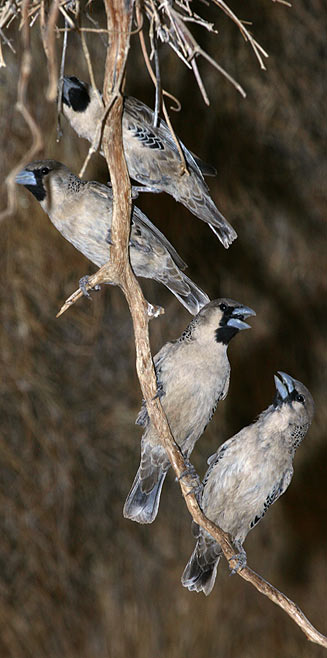 |
 |
|
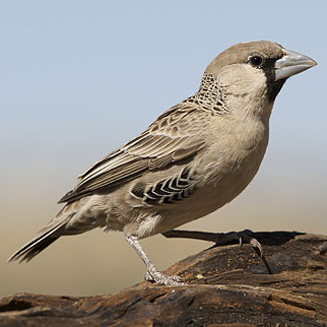 |
|
Sociable weavers, Northern Cape, South Africa. [photo
© H. Robertson, Iziko] |
Top right: Sociable weaver working on its nest,
Northern Cape, South Africa. [photo
© H. Robertson, Iziko]
Bottom right: Sociable weaver, Kgalagadi National
Park, South Africa. [photo
Johann Grobbelaar
©] |
Distribution and habitat
Endemic to southern Africa, occurring from Namibia through
south-eastern Botswana to the Northern, North-West and Free State Provinces of
South Africa. It generally prefers arid savanna and woodland, although it may
move into grassland, Mopane (Colosphermum mopane) woodland and the
largely treeless Namib Desert, the latter permitted by the introduction of
artificial structures which it uses as nest sites.
|
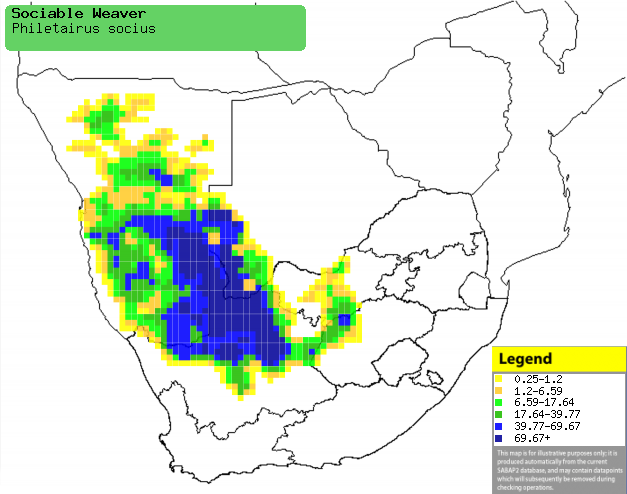 |
|
Distribution of Sociable weaver in southern Africa,
based on statistical smoothing of the records from first SA Bird Atlas
Project (©
Animal Demography unit, University of
Cape Town; smoothing by Birgit Erni and Francesca Little). Colours range
from dark blue (most common) through to yellow (least common).
See here for the latest distribution
from the SABAP2. |
Predators and parasites
It (at various stages of development) has been recorded as
prey of the following animals:
- Adults and fledglings
- Eggs and chicks
Adults and chicks have been recorded as hosts of the
following parasites:
- blood-sucking larvae of the beetle Dermestes
- Argas striatus (tick)
- Myrsidea ledgeri (chewing louse)
- Haematophagous mites
- hippoboscid flies
- Diplotriaena ozouxi (nematode worm)
Food
It mainly eats seeds, supplemented with termites and other
insects, foraging in large flocks which pluck food from the ground. The following food items have been recorded
in its diet:
- Plants
- seeds
- basal nodes of grasses, flowers and fruit
- Insects
- Hodotermes mossambicus (Northern harvester termite)
- moths and caterpillars (Lepidoptera)
- small grasshoppers (Orthoptera)
- Coleoptera
(beetles and their larvae)
- ants
Breeding
- Colonial cooperative breeder, living in colonies of up to about 500 birds,
all coexisting in a massive communal nest (see images below) which can be
about 7 metres long, weigh at least one tonne and can even be over 100 years
old! It consists of two parts; the colony is protected by a roughly domed
roof made of fairly large and often thorny twigs, or occasionally of grass
leaves and stems. Beneath this it creates a substructure of dry grass
(especially Tall bushman grass (Stipagrostis ciliata) in the
Kalahari), within which many short, downward vertical tunnels are placed,
each ending in a chamber set to one side. The interior of each chamber is
lined with soft material such as grass seedheads, everlasting (Helichrysum)
leaves and feathers. The members of colony continually maintain and on
material to the nest, but if the structure falls to the ground, the colony
abandons it along with the chicks and eggs within it.
- It is typically attached to a strong, vertical tree branch with plenty
of space below it, but it also commonly uses man-made structures; the
following trees and objects have been recorded as nest sites:
- Trees
- Acacia
- A. erioloba (Camel thorn)
- A. tortillis (Umbrella thorn)
- A. haemotoxylon (Grey camel thorn)
- Boscia albitrunca (Shepherds-tree)
- Aloe dichotoma (Quiver tree)
- Rhus lancea (Karee)
- Ziziphus mucronata (Buffalo-thorn)
- Colosphermum mopane (Mopane)
- alien plants (rarely)
- Eucalyptus
- Prosopis (mesquite)
- Man-made structures
- telephone poles (most commonly)
- electricity pylons
- railway pylons
- tank-stands
- wind pumps
- beams of sheds
- rock faces (only in Asbestos Mt., Northern Cape)
|
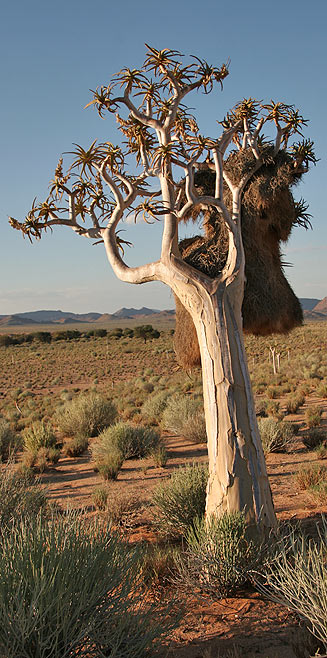 |
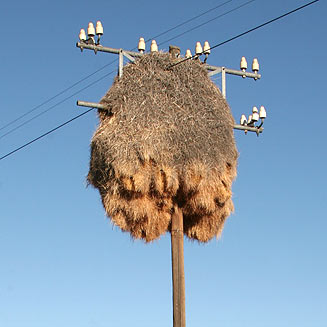 |
|
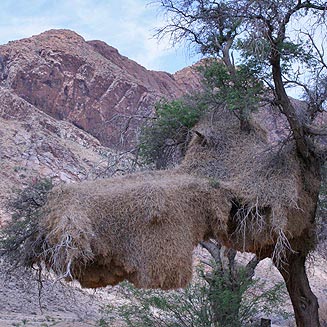 |
|
Left: Nest in
Kokerboom tree; Top right: Nest around telephone line; Bottom right:
Nest in
Acacia tree.
[all 3 photos
© H. Robertson, Iziko] |
- In arid areas it only breeds after about 20mm of rain has fallen, however
along the eastern edge of its distribution egg-laying season is more
predictable, beginning from August-September. It may lay up to 9 clutches in
a breeding season if rainfall is good, but in dry years it may not rear
young at all, in fact in the drought from 1956-1959 in Namibia it did not
breed in the roughly 100 colonies recorded.
- It lays 2-6 eggs, which are incubated for about 13-15 days by both sexes
and sometimes helpers.
- The chicks are brooded continuously by both parents for the first 10-14
days of their lives, and are assisted with feeding the chicks by up to 9
helpers, which are usually young from the previous brood (sometimes only
25-30 days old) but are sometimes unrelated. The young leave the nest after
about 21-24 days, remaining dependent on their parents for food for
approximately 30-45 days more.
Threats
Not threatened, in fact its population has increased
substantially over the past 100 years, as it has moved into treeless areas where
it uses artificial structures as nest sites.
References
-
Hockey PAR, Dean WRJ and Ryan PG 2005. Roberts
- Birds of southern Africa, VIIth ed. The Trustees of the John Voelcker
Bird Book Fund, Cape Town.
|
